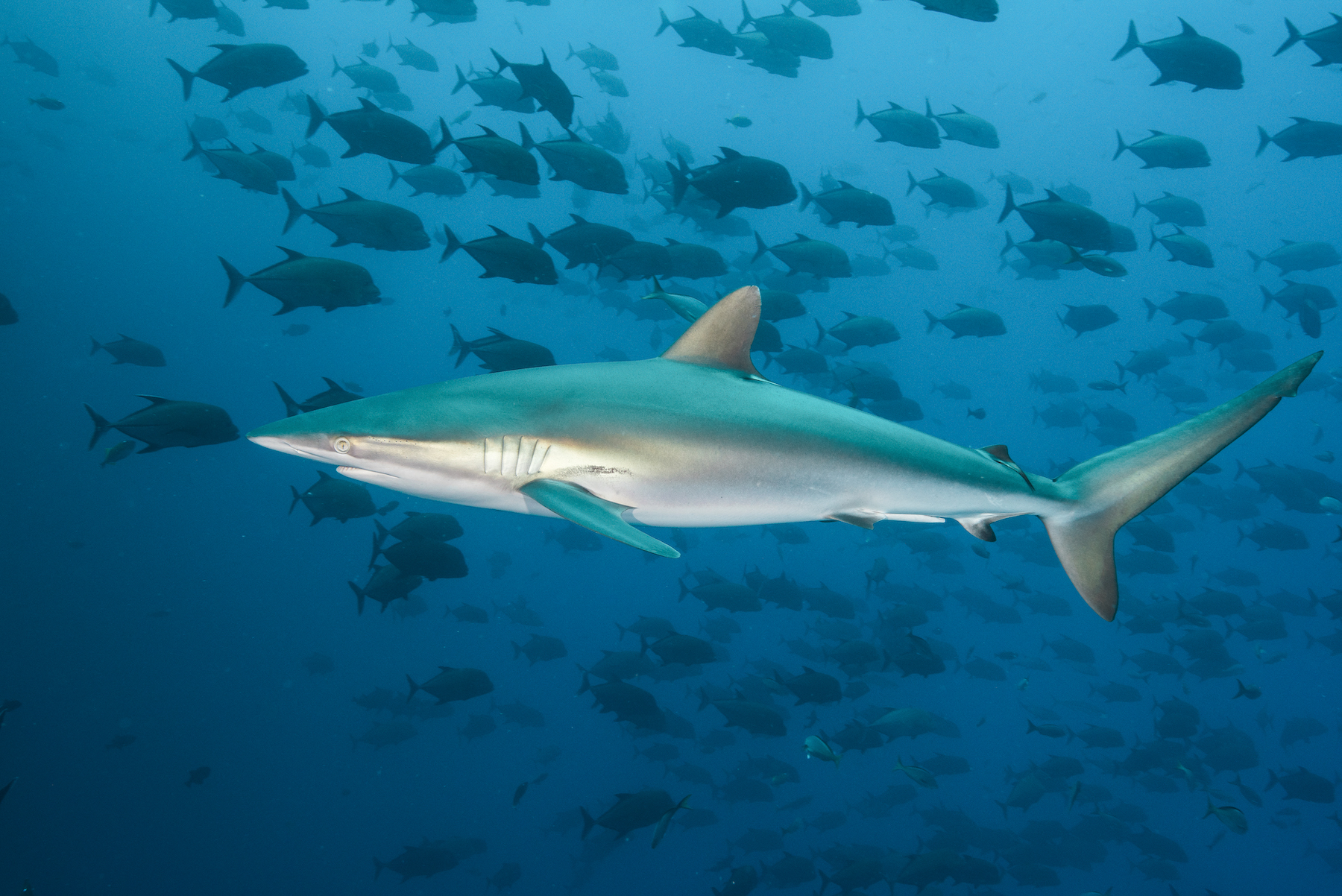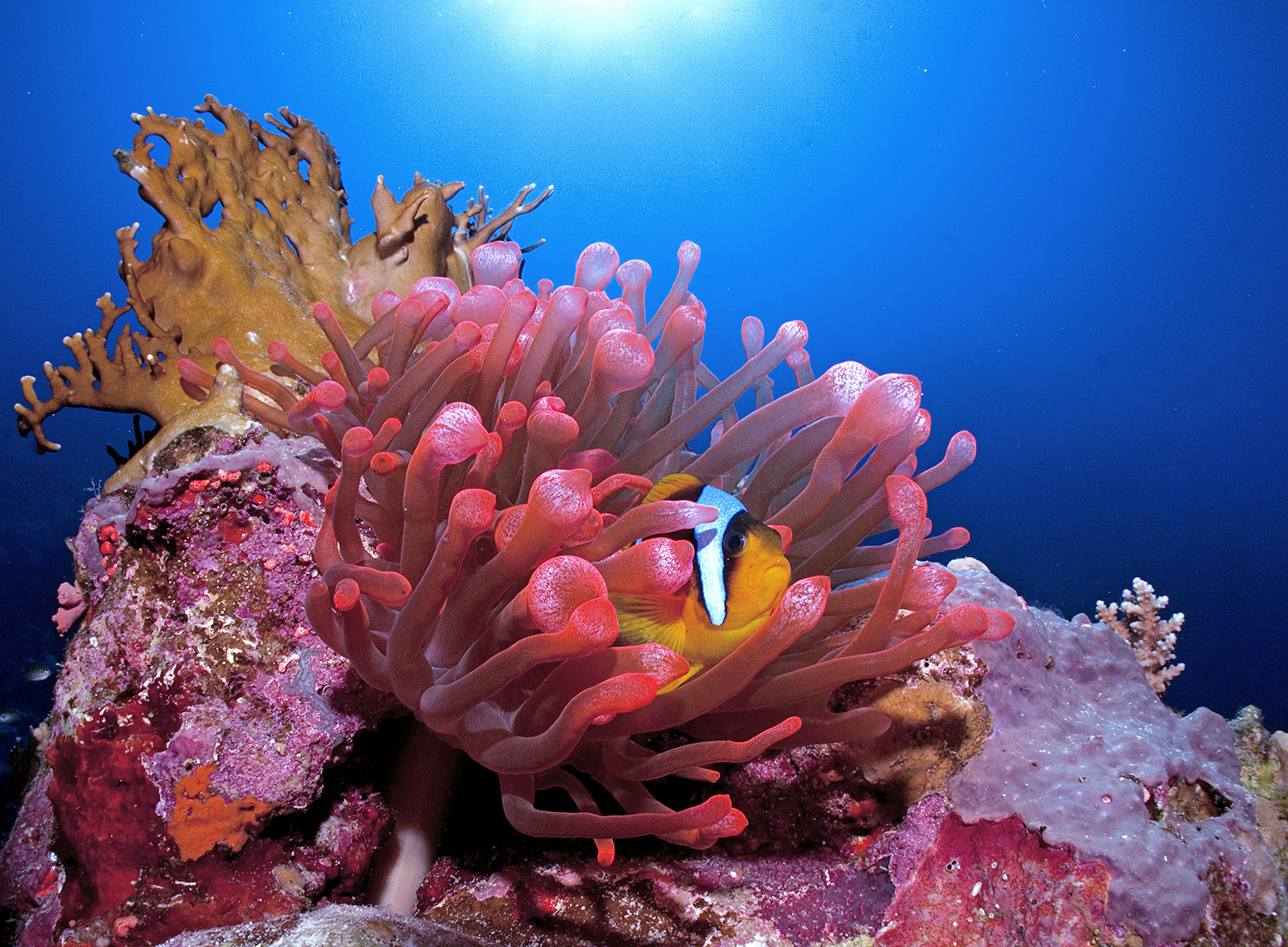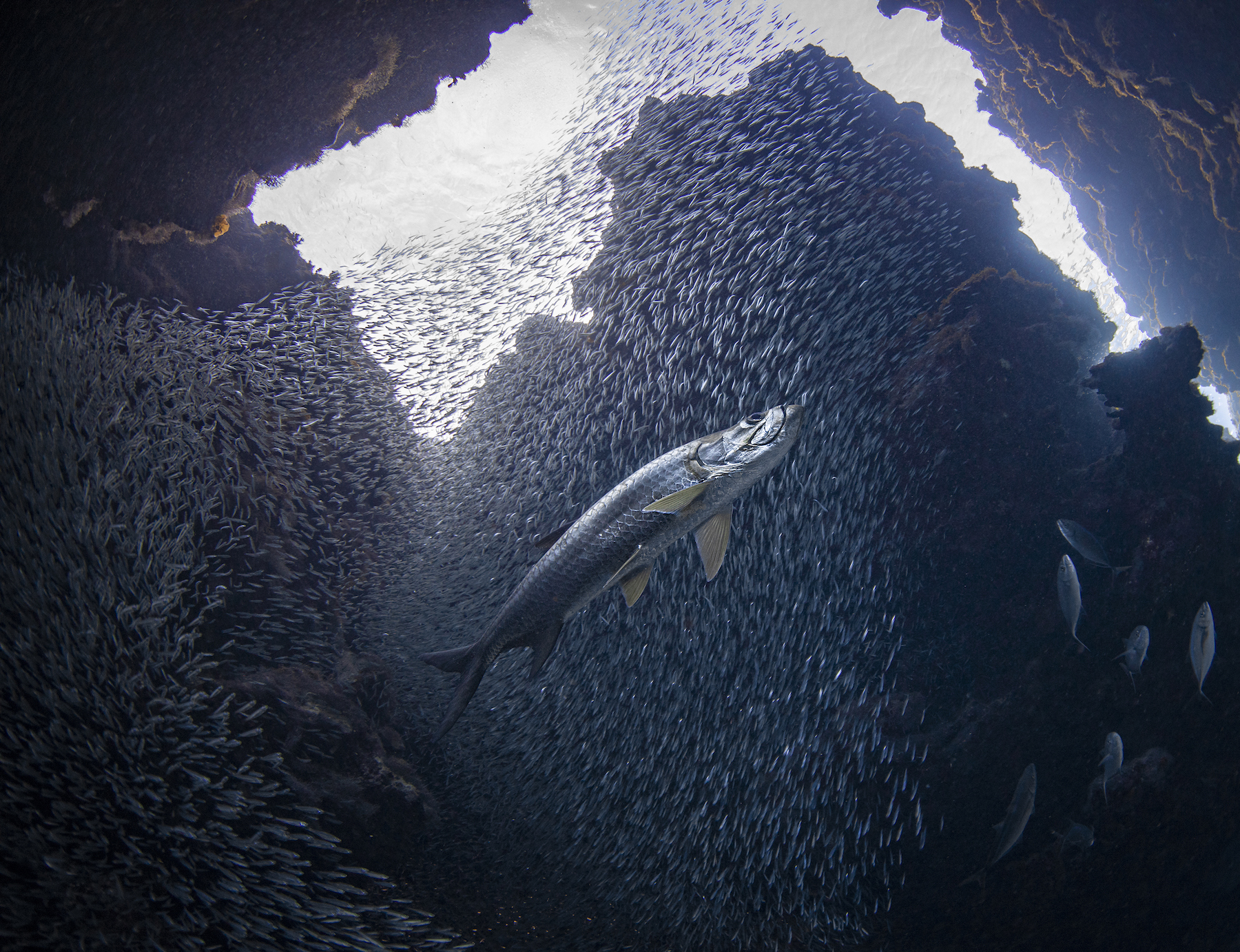- Which one of the following is a marine fish? /निम्नलिखित में से कौन सी एक समुद्री मछली है?
- Rohu / रोहू
- Hilsa / हिल्सा
- Catla / कैटला
- Common Carp / कॉमन कार्प
Answer / उत्तर :- Hilsa / हिल्सा
Fish living in the Ocean
As mentioned above, the ocean contains an incredible amount of life. Here we’ll give you a list of 43 species of fish you can find living in the ocean, both in coastal waters, out in open waters, and in deep sea.
- Hilsa
- Swordfish
The swordfish is an elongated, scaleless fish with a tall dorsal fin, and a long sword. It can be found in warm and temperate oceans around the world. Swordfish have a dorsal fin, similar to that of sharks; marlins, on the other hand, have a single dorsal fin that connects along the fish’s back to a short, soft-looking ridge. Sailfish can be recognized by the large dorsal fin that looks like a sail with accordion pleats.
- Atlantic Cod
Atlantic cod (Gadus morhua), a cold-water fish found on both sides of the North Atlantic, is often simply referred to as cod. Atlantic cod prefers to stay close to the seafloor. It is prized for its edible flesh, liver oil, and other by-products. It’s a dark-spotted fish with three dorsal fins, two anal fins, and a chin barbel. It can be greenish or greyish, brown or blackish, or dull to bright red.
- Mackerel
A streamlined food and sport fish that lives in temperate and tropical oceans around the world; it is related to tunas. Mackerels have a rounded, torpedo-shaped body, a forked tail, and a series of tiny finlets behind the dorsal and anal fins. It eats plankton, crustaceans, mollusks, fish eggs, and smaller fish.
- Trout
Salmon and trout are closely related. Salmonidae (order Salmoniformes) are prized game and food fish that are mainly restricted to freshwater, though a few species travel to the sea between spawnings.
- Atlantic Salmon
The Atlantic salmon (Salmo salar) is an oceanic trout of the Salmonidae family. It weighs approximately 5.5 kg (12 pounds) and has circular or cross-shaped markings. It can be found on both sides of the Atlantic Ocean basin, and it spawns in streams in the fall.

- Tuna
The genus Thunnus contains seven species of oceanic fish, some of which are very large and have a high commercial value. They are related to mackerels and belong to the same Scombridae family as them. They are streamlined, elongated fish with a rounded body that tapers to a narrow tail base and a forked or crescent-shaped tail. Their specialized body shape, fins and scales enable them to become one of the fastest fish in the ocean: some species of tuna can swim as fast as 43 miles per hour.
- Whale shark
Whale sharks (Rhincodon typus) are the only member of the family Rhincodontidae, is the largest extant fish in the world, growing up to 11 m (39 ft) in length. It feeds primarily by filtering surface water, catching plankton, and small crustaceans or fish. It inhabits warm tropical and subtropical waters.
- Red Mullet
The Mediterranean red surmullet, or red mullet (Mullus barbatus) was one of the ancient Romans’ most cherished eating fishes. It inhabits saltwater or brackish water and frequent shallow, inshore locations, scrounging for microscopic plants, small animals, and other food in the sand or mud.
- Mahi Mahi
The mahi-mahi (Coryphaena hippurus), also known as the common dolphinfish, is a ray-finned surface-dwelling fish found in temperate, tropical, and subtropical waters around the world. Dorado is another name for it. When they are out of the water, the fish often changes colour, going through several hues before finally fading to a muted yellow-grey upon death.
- Anchovy
Saltwater fishes in the Engraulidae family (order Clupeiformes) are related to herring and have a big mouth that nearly always extends behind the eye, and a pointed snout.
- Haddock
This is a valuable North Atlantic food fish that is often smoked and sold as “finnan haddie.” The haddock is a carnivorous bottom-dweller that feeds on invertebrates and small fish. It looks like a cod.
- Red Sea Bream Fish
Porgies, sometimes known as sea breams, are snapper or grunt-like fish with a high back. They have only one dorsal fin, and with their small mouths, which are equipped with sharp teeth, they eat fish and hard-shelled crustaceans.
- Gold Line Fish
Sarpa salpa, also known as the dreamfish, salema, salema porgy, cow bream, or goldline, is a type of sea bream with golden stripes that run the length of its body and can cause Ichthyoallyeinotoxism if consumed. It can be found in the East Atlantic, from the Bay of Biscay to South Africa, and in the Mediterranean.
- Pollack
Pollock, often written pollack, is a North Atlantic fish belonging to the Gadidae family of cod. The pollock is a long, dark green fish with a light belly and lateral line.
- Ocean Sunfish
The Mola, commonly known as ocean sunfish or head fish, is one of six oceanic fish species belonging to the Molidae family. Molas have a bullet-like look, with a short body that abruptly ends in a thick rudder-like structure. They are the heaviest bony fish, the record was given to a specimen which was 2,300 kilograms in weight and 2.72 metre long.

- Northern Red Snapper
The northern red snapper (Lutjanus campechanus) is a ray-finned marine snapper that belongs to the Lutjanidae family. It is found in the western Atlantic Ocean, the Caribbean Sea, and the Gulf of Mexico, where it lives in reef-like settings.
- Bonito
This is a tuna-like schooling fish belonging to the Scombridae family of tuna and mackerel. Bonitos are fast, predatory fish found all across the world.
- Clown Fish
Clown anemonefish are among the most recognized of all reef-dwellers, with their bright orange color and three unmistakable white bars. They grow to be approximately 4.3 inches long and get their name from the multicolored sea anemone in which they live.
- Emperor Angelfish
The emperor angelfish (Pomacanthus imperator) is a marine angelfish species. It’s a reef-associated fish that can be found from the Red Sea to Hawaii and the Austral Islands in the Indian and Pacific Oceans. These fish when they are born have a ringed colour pattern (black, white and blue) and as they mature, their skin pattern, and colour changes “
- Bluefish
The only member of the Pomatomidae family, popularly known as tailor or snapper, is a fast-moving marine food and game fish. The bluefish lives in schools and preys voraciously on other, smaller species throughout the Atlantic and Indian oceans’ warm and tropical regions.
- Ornate eagle ray
Ornate eagle rays (Aetomylaeus vespertilio) inhabit bays, sandy areas and coral reefs at depths to 100 m along the coasts of the Indian, and Pacific Ocean basins. It can considerably grow up to 4m and they lack a spine on the tail, it is deemed harmless to humans, thus this species is rarely observed and may be naturally uncommon.
- Leafy sea dragon
Also known as Glauert’s seadragon (Phycodurus eques), this is a marine fish belonging to the family Syngnathidae, which includes seadragons, pipefish, and seahorses. It can be found in Australia’s southern and western beaches. The name comes from the look, which features lengthy leaf-like protrusions all over the body. These protrusions are only employed for concealment and not for propulsion.
- Great hammerhead shark
This species is distinguished by a flattened hammer- or shovel-shaped head. The great hammerhead (S. mokarran) can reach a length of nearly 6.1 meters (20 ft). Sphyrnidae sharks have been found in the fossil record dating back to the early Miocene Epoch, despite being one of the most recently evolved shark groups.
- Dragonfish
Also called sea moth, it is a small marine fish that belongs to the Pegasidae family. It lives in the warm Indo-Pacific seas. It is a small, elongated fish coated in bony rings of armor and grown to approximately 16 centimeters (6 1/2 inches).

Deep-sea fish
Beneath the ocean’s crushing blackness lies an ecosystem that has learned to thrive without sunlight or warmth. It’s a world full of organisms with unique adaptations to such a challenging environment. Welcome to the abyss.
- Starry handfish
Halieutaea stellata is a batfish belonging to the Ogcocephalidae family that may be found on the continental shelves of the Indo-Pacific waters at depths of 50 to 400 meters. It can grow up to 30 centimeters in length.
- Ocellated frogfish
Fowlerichthys ocellatus is the largest Caribbean frogfish. Its body is spherical and somewhat compressed; the head is not spiny and the eyes are on the sides of the head. The mouth is quite large and upward pointed, with many little teeth.
- Shortnose batfish
The flattened body of the Shortnose Batfish (Ogcocephalus nasutus) is fashioned like a rounded triangular disc that is broader in the front and narrower at the tail. The color of its dorsal side varies from black to red-brown.
- Prickly anglerfish
The prickly anglerfish (Himantolophus appelii) is a football fish of the Himantolophidae family that can be found in deep water in the southern oceans (excluding the eastern Pacific). It can be up to 40 centimeters long (16 in).
- Longlure frogfish
The longlure frogfish (Antennarius multiocellatus) is a frogfish species found in the western Atlantic, from Bermuda and the Bahamas along the coastlines of Central and South America to Brazil, in warm reefs with rich sponge populations. It is a bottom dweller that imitates nearby sponges by changing its background color to match the dominant sponge in the vicinity.
- Viperfish
Chauliodus is a genus of saltwater fish that includes nine species (order Stomiiformes). They live in the tropical parts of the world’s oceans. Viperfishes are deep-sea dwellers with luminous organs on their flanks; the lights are occasionally used to attract other fish that they feed on.
- Lanternfish
Several kinds of small, abundant deep-sea fish belong to the Myctophidae family. Some lantern fish can be found at depths of up to 300 meters. They have big mouths and eyes, as well as numerous light organs on their heads, undersides, and tail bases.
- Anglerfish
Anglers get their name from the way they “fish” for their prey. On the skull, the foremost spine of the dorsal fin is transformed into a “fishing rod” capped with a fleshy “bait.” Prey fish drawn to this bait stray close enough to be swallowed by the anglerfish. Female anglerfish are much bigger compared to male individuals: when the male finds a female to reproduce with, it becomes a parasite of the female, feeding from her blood while only providing the sperm to fertilise the eggs.
- Barreleye
The Pacific spookfish barreleye (Macropinna microstoma) can be found along the North American coast. It is brownish in color and less than 10 cm (4 inches) long.
- Stargazer fish
Stargazers are known for burying themselves in the bottom of the sea. Their bodies are tapered, and their heads are large, heavy, and flat. Their lips are fringed, and their eyes are on top of their heads (hence the common name).
- Atlantic wolffish
Anarhichas lupus can be found in the waters of the northern Atlantic and Pacific. The largest species can grow up to 2.3 metres in length (7.5 feet). Wolffish have a huge head and a long tapered body with a single long dorsal fin at the top.
- Cookiecutter shark
Sometimes known as the cigar shark (Isistius brasiliensis), it belongs to the Dalatiidae family of small squaliform sharks. This shark can be found in warm marine seas all around the world, especially near islands, and has been seen at depths up to 3.7 kilometers (2.3 mi). The cookiecutter shark gets its name from the cookie-shaped bite wounds it leaves on its prey. The shark’s unique teeth and short, coned snout create these round chunks
- Black swallower
Chiasmodon niger, often known as the black swallower, is a deep sea fish belonging to the Chaetodontidae family. It is notable for being able to consume fish that are larger than itself thanks to its extendable stomach. It can be found in tropical and subtropical waters at depths of 700–2,745 m (2,297–9,006 ft) in the mesopelagic and bathypelagic zones.
- Atlantic footballfish
The Atlantic footballfish (Himantolophus groenlandicus), sometimes known as the Atlantic football-fish, is an anglerfish that lives in the mesopelagic depths of the ocean. Despite its name, this species’ range may expand beyond the Atlantic Ocean basin, into the Indian Ocean basin, and the Pacific Ocean basin. It can be found in both tropical and temperate climates.
- Fangtooth
Fangtooths are deep-sea beryciform fish belonging to the family Anoplogastridae (sometimes written “Anoplogasteridae“). The term comes from the Greek words anoplo, which means “unarmed,” and gaster, which means “stomach.” The family has two highly similar species in one genus, with no known close relatives, and has a global distribution in tropical and cold-temperate waters.
- Red-lipped batfish
The Galapagos batfish (Ogcocephalus darwini) is an unusually shaped fish found in the Galapagos Islands and off Peru, at depths of 3 to 76 meters (10 to 249 ft). The rosy-lipped batfish (Ogcocephalus porrectus), which may be found at Cocos Island off Costa Rica’s Pacific coast, is closely related to it.
- Hairy frogfish
Also known as striated frogfish (Antennarius striatus), this is a marine fish in the Antennariidae family. It can reach a length of 22 cm (8.7 in) and has a spherical, extensible body. Its soft skin is coated with unevenly distributed dermal spinules that resemble hairs, just like other members of its family.
- Oarfish
The oarfish (Regalecus glesne) is the longest fish in the deep sea, reaching up to 11 m in length. Found in areas spanning from temperate ocean zones to tropical ones, and are usually found more than a thousand meters below the surface, yet rarely seen.
- Pigfish
The pigfish, also known as the hogfish, red mouth grunt, or sailor’s choice, is a ray-finned fish that belongs to the Haemulidae family. It lives in The western Atlantic Ocean. The grunting or chattering sounds this fish produces by rubbing its pharyngeal teeth together earns it its name.















No comments:
Post a Comment